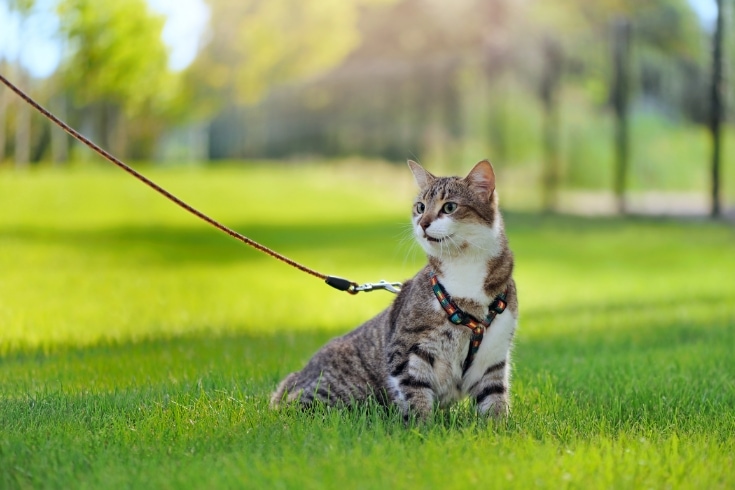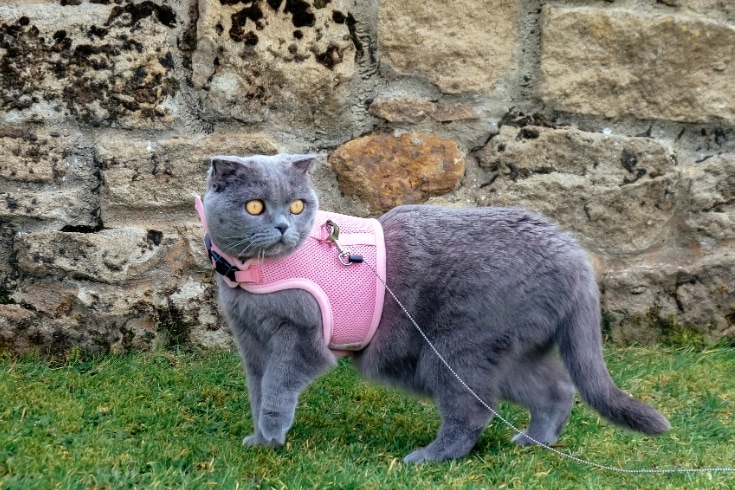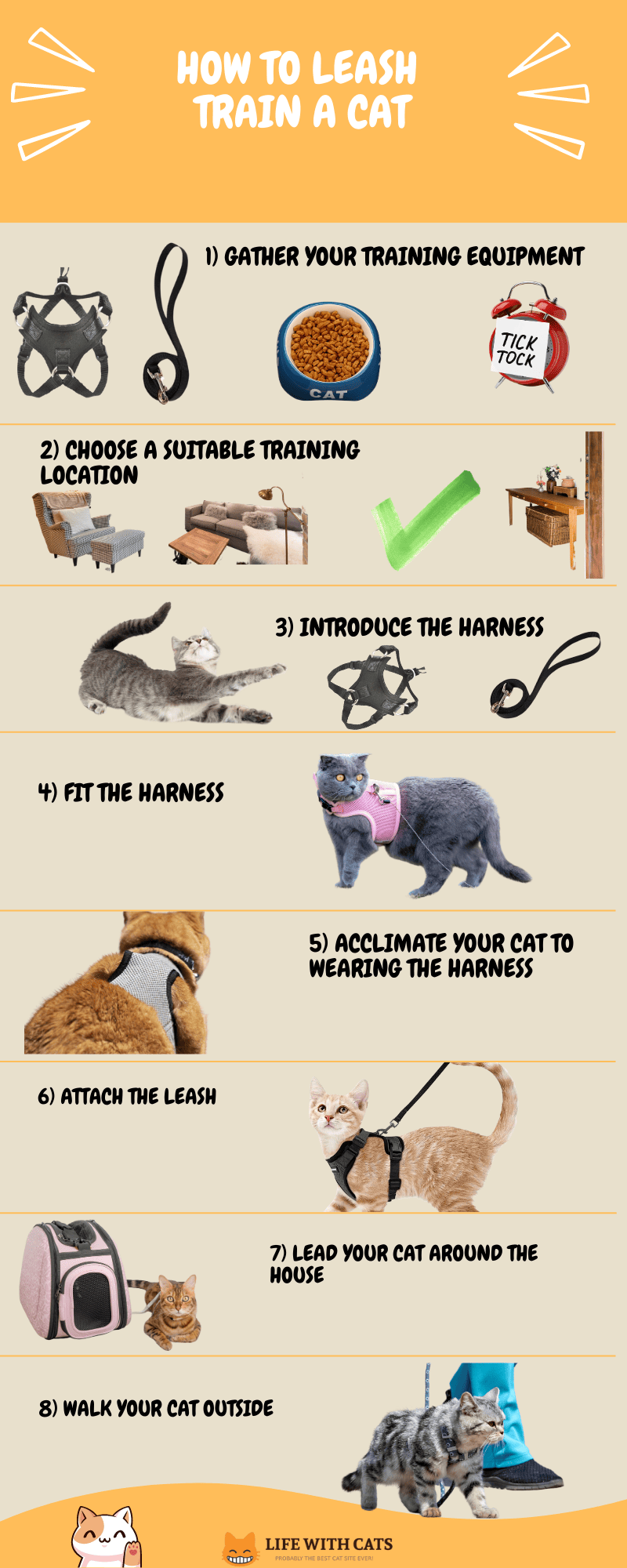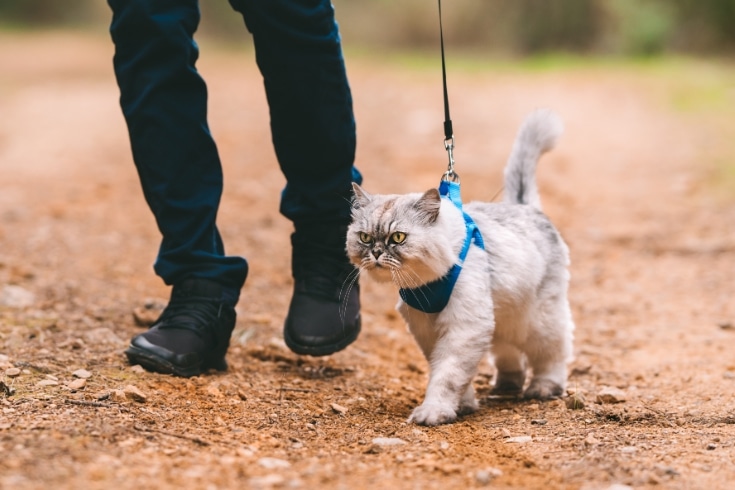Cat leash training teaches your cat to become comfortable wearing a harness and walking on a leash. That allows your cat to explore her outdoor environment while safely under your control and supervision.
Cat leash training can provide your pet with mental and physical stimulation without the risk of her getting lost, injured, or even stolen while she’s exploring outside. Walking your cat on a leash can also help to build a stronger bond with your feline companion.
Some cat breeds are easier to train to walk on a leash, including Maine Coons, Abysynnian, Bengal, and Siamese. That said, it is possible to train any cat breed to walk on a leash by using positive reinforcement training and being patient and consistent with your training methods.
Never force your cat to wear a harness and leash!
In this guide, you can learn how to leash and harness train your cat using positive reinforcement so that she can safely have fun in the outdoor environment.
What Are The Benefits Of Leash Training A Cat

The benefits of leash training a cat are listed below:
Can Help You Bond
Provided you use positive reinforcement training methods to teach your cat to walk on a harness and leash, the experience can help you form a strong bond with your cat.
Will Get More Exposed To Nature
Some indoor cats only get to enjoy a limited view of the Great Outdoors when sitting on a windowsill and looking out.
With a harness and leash, your cat gets to enjoy the sights, sounds, and smells of nature outside in your back garden or yard. I’ve even seen cats being walked around the neighborhood on their harness and leash!
That’s fantastic news for cats that must live indoors for health reasons. For example, I once owned a shelter cat who had lost most of her sight, so it was no longer safe for her to roam around outdoors. I taught her to wear a harness and leash so that she could still enjoy feeling the sun on her back and explore my back garden safely, even though her vision was seriously impaired.
High-value show cats often live indoors to protect them from thieves but can still enjoy a taste of nature when walking in your backyard on a leash.
Helpful When Traveling With Your Cat
Many owners travel with their pets, which can sometimes mean needing to remove the cat from its carrier. Having your cat securely attached to a harness and leash is much safer than having her on your lap, especially in a busy airport or train station.
Will Enrich Your Cat’s Life
Enjoying a stronger bond with you and getting to spend time exploring a different environment will greatly enrich your cat’s life, so training her to wear a harness and walk on a leash is an excellent idea.
Great For Apartment Living
If you live in an apartment, learning to wear a harness and walk on a leash enables your cat to experience a different environment safely, either walking down the street with you or pottering around your backyard.
Which Cats Can Be Leash Trained?

The cat breeds that can be leash trained are listed below, although it’s important to know that you can leash train any breed with patience and positive reinforcement.
- Ragdoll: The Ragdoll is a cat breed with a beautiful, silky colorpoint coat and startling blue eyes. These felines are renowned for their placid, affectionate temperament.
- The Abyssinian: Abyssinian cats have unique coats with bands of color on each individual hair and a coat that appears darker along the cat’s spine. These affectionate, sociable cats can be quite “clingy” to their owners.
- Bengal: Bengals are distantly related to Asian Leopard cats, having a gorgeous coat with distinctive leopard markings. These are energetic, friendly cats that are typically easy to leash train.
- Burmese: Burmese cats are extremely social, friendly cats that love to be around their owners, although they can be somewhat vocal.
- Maine Coon: Maine Coons are affectionately known as the gentle giants of the feline world, having a thick, dense coat that helps them survive the harsh Maine climate. The Maine Coon’s dog-like behavior makes them easy to leash and harness train.
- Siamese: Siamese cats come from Thailand and are known for their friendly, affectionate nature and vocalization. These lovely creatures can typically be leash-trained relatively easily.
- Turkish Van: Turkish Vans have a distinctive white coat, blue or amber eyes, and sometimes one of each! These cats are known to enjoy swimming and can also be leash-trained.
- British Shorthair: The British Shorthair cat is the oldest native breed in the UK and is best known for its thick, dense, gray-blue coat and pineapple-colored eyes. These friendly, sociable cats are usually easy to leash-train.
- American Shorthair: American Shorthair cats are thought to be related to the British Shorthair cats that were brought to the US by settlers who needed cats to control rodents on their ships.
- Ocicat: Ocicats are large, shorthaired cats with an unusual spotted tabby coat pattern and a friendly, trainable nature.
- Pixie-bob: Although unrelated to the American Bobcat, the Pixie-bob resembles its wild cousin with similar coat coloring and a bobbed tail. These friendly felines don’t meow, preferring to vocalize with chirps, growls, and chatters.
- Somali: The Somali cat is intelligent and active, making it an ideal candidate for leash training. These cats are closely related to the Abysynnian but have long, luxuriant coats.
- Korat: Korats are intelligent, loving lapcats that are revered in their native Thailand as “good luck cats” and are traditionally given in pairs to brides as wedding gifts.
- Savannah: The Savannah cat might look like a wild cat, but it’s a domestic breed that’s known for its intelligence and desire to stick to its owner like glue. We think that makes these beauties perfect candidates for leash training.
- Persian: Persian cats are best known for their glorious, long, silky coats and flat faces. Did you know a Persian cat won the world’s first cat show? These pretty kitties can also learn to walk on a harness and leash; how cool is that?
What Are The Things You Need To Leash Train A Cat

The things you’ll need to leash train a cat are as follows:
- A Specialist Cat Harness: You can’t use a small dog harness to train your cat because it won’t fit properly. So, be sure to choose a harness that’s designed for cats.
The harness fits around your cat’s chest and shoulders so that there’s no pressure on her neck. Cat harnesses come in different colors and fabrics, most of which are washable, and many are padded for extra comfort.
- Lightweight Nylon Or Cloth Leash: You’ll need a leash specially designed for use with a cat harness because dog leashes are generally too heavy for use with a creature as small and lightweight as a cat.
You can generally buy a leash to match your chosen cat harness, which looks very smart when your feline friend is out with you, patrolling her territory!
- Tasty Treats: If your cat loves edible rewards, you’ll need a supply of her favorite tasty treats to give as rewards throughout the leash and harness training exercise.
Investing in a small food or treat pouch or container can be useful, which is much handier than rummaging in a plastic bag for your cat’s favorite reward.
- Patience And Time: Leash training doesn’t often happen overnight, so you’ll need to put aside plenty of time for your training program.
In addition, although some cat breeds are easier to train than others, every cat is different, so you’ll need lots of patience, especially if you’re training an older cat that might not accept the idea of wearing a harness straight away.
- Quiet And Safe Training Area: Cats are easily distracted, so, no matter what you’re training your cat to do, you’ll need a quiet, safe indoor area to start your training.
Once your leash training has become established, you’ll need somewhere outside that’s peaceful and well away from busy traffic and distractions.
How To Leash Train A Cat

Here’s a step-by-step guide on how to leash train your cat.
Step 1 – Gather Your Training Equipment
Start by gathering together everything you’ll need to leash train your cat, including your harness, leash, and a supply of her favorite treats.
Step 2 – Choose A Suitable Training Location
Now, select a quiet spot in your home where you won’t be distracted or interrupted. It’s also a good idea to switch off your cell phone and pick a time when you’re not expecting deliveries or callers to your home.
Step 3 – Introduce The Harness
Show the harness to your cat before you try to fit it so that she’s familiar with her new accessory and not afraid of it.
Whenever your cat shows positive behavior, reward her immediately with treats and praise.
Step 4 – Fit The Harness
Once your cat is happy with the harness, fit it gently, ensuring that the piece of kit fits snugly so it doesn’t rub and won’t come off but isn’t so tight that the cat can’t move.
Step 5 – Acclimate Your Cat To Wearing The Harness
Allow your cat to wear the harness around the house for short periods, gradually increasing the length of time she’s wearing it over several days. Remember to offer your cat plenty of treats or her preferred reward so that she learns to associate positive things with the harness.
Step 6 – Attach The Leash
Once your cat is comfortable wearing and moving around in the harness, fix a lightweight leash to it and allow your furry friend to move around the house, dragging the leash.
During this time, never leave your pet unsupervised in case the leash gets hooked up to something, and your pet frightens herself.
Step 7 – Lead Your Cat Around The House
When your cat is happy to move around dragging the leash, pick up the leash and encourage the cat to move around with you.
Begin with short training sessions indoors, rewarding your pet with praise and treats for walking alongside you.
Step 8 – Walk Your Cat Outside
When your cat is happy to walk alongside you indoors, you can take her outside for walks in a safe, secure environment. Supervise your cat closely at all times in case something spooks her.
Throughout the training process, use positive reinforcement and reward your cat for everything good that she does. Never punish your cat or try to force her to walk if she’s resistant since that can create negative associations with the harness and leash.
What Are Effective Tips To Leash And Harness Training A Cat?

Here are effective cat harness and leash training tips.
- Buy a harness and leash that are designed for use with cats.
- Always use positive reinforcement training methods.
- Don’t punish your cat or try to force her to wear the harness if she doesn’t want to at first.
- Take your time and allow your cat to investigate and accept the harness before you try to fit it.
- Ensure the harness fits snuggly without preventing your cat from moving freely.
- Choose a quiet, safe space for training where you won’t be disturbed, and your cat won’t be distracted.
- Practice indoors first before moving outside to a safe, secure area where your cat can’t escape if she’s spooked.
- Be patient and consistent throughout your training.
Cat Leash Training FAQs
Here are the answers to some of the most commonly asked questions about leash and harness training a cat.
Can You Leash Train A Cat?
Yes, you can leash train a cat, although the process can be somewhat more challenging than leash training a dog, depending on how independent your cat is and her age.
Do Cats Need Leashes?
No. Cats do not legally need to be leashed when out in public. However, walking your cat on a leash is much safer than allowing her to roam outside, especially if you live in a very busy area with lots of traffic.
Can You Train A Cat Like A Dog?
Yes, you can train cats to perform simple commands, such as “sit,” “stay,” and play dead, in much the same way as you would train a dog.
Can You Walk A Cat On A Leash?
Yes, you can walk your cat on a leash, provided she is wearing a correctly fitted cat harness. Never walk your cat on a collar, as she could be injured if something startles her, and she pulls away or jumps.
When Should You Start Leash Training A Cat?
The best time to start training your cat to walk on a leash is when she is a kitten or a young adult cat. That said, you can train older cats to walk on a harness and leash, although the process often takes longer.
What Is The Difference Between A Cat Leash And A Harness?
A harness is a padded, wearable device that fits around the cat’s shoulders and chest, fastening on the top of the back via a snap buckle.
A leash is a lightweight length of cord or cotton fabric that fixes to the harness via a clip on one end. The other end of the leash has a handle so that you can hold and direct your cat as she walks.
Conclusion
Did you enjoy our guide on leash and harness training your cat? If you did, please hit the share button before you go!
Cat leash training trains your feline friend to wear a harness and walk on a leash, allowing your cat to explore her outside environment safely and under your control and supervision.
Walking your cat on a leash provides your pet with mental and physical stimulation without the risk of her getting stolen or lost while she’s having fun wandering outside. Leash walking your cat also helps to build a strong bond between you.
You can train any cat to walk on a leash, although some cat breeds, including Siamese, Bengal, and Maine Coons, are easier to train than others. Whatever your cat’s breed, always be patient and never force the harness and leash on her.
Do you walk your cat on a leash and harness? Tell us about your experiences in the comments box below!